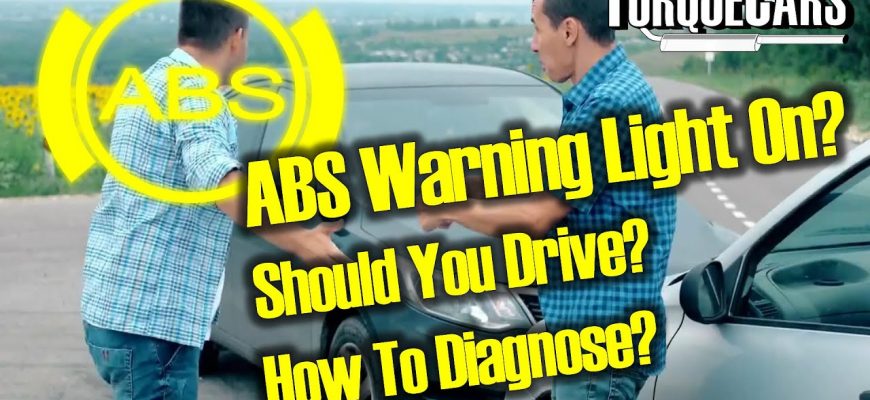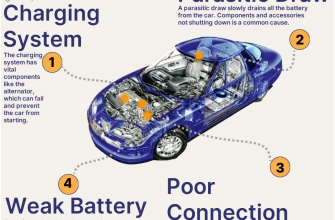Driving with warning lights on your dashboard is never a comforting experience, and the ABS (Anti-lock Braking System) light is no exception. When this light illuminates, it raises a crucial question for drivers: Is it safe to continue driving? In this article, we will explore what it means when the ABS light comes on, the potential risks involved, and what steps you should take if you find yourself in this situation.
Understanding the ABS Light
The ABS light on your dashboard acts as a warning signal that something is amiss with your vehicle’s braking system. ABS is designed to prevent your wheels from locking up during braking, allowing you to maintain steering control in emergency situations. When the ABS light is lit, it indicates that the system is not functioning properly. However, the vehicle’s conventional braking system may still be operational.
What Causes the ABS Light to Illuminate?
There are several reasons why the ABS light may turn on, including:
- Faulty Wheel Speed Sensors: These sensors monitor the speed of each wheel and communicate with the ABS module. If a sensor fails, the ABS light may activate.
- Low Brake Fluid Levels: Insufficient brake fluid can trigger the ABS light, indicating a potential leak or other issue within the braking system.
- Electrical Issues: Problems with wiring, fuses, or the ABS module itself can lead to the ABS light coming on.
- Worn Brake Components: If brake pads or rotors are excessively worn, it may affect the ABS system’s performance.
The short answer is: it depends. While your vehicle may still function normally with the ABS light on, there are important considerations to keep in mind:
- Standard Braking Still Works: In most cases, your regular braking system is unaffected, which means you can stop your vehicle. However, without the ABS, your brakes may lock up during hard stops, especially on slippery surfaces.
- Reduced Control: The absence of ABS means you may lose some control during sudden braking situations. This is particularly dangerous in adverse weather conditions like rain or snow.
- Potential for Further Damage: Ignoring the ABS light can lead to more severe issues within the braking system. What starts as a minor sensor issue can escalate into a costly repair if left unaddressed.
What to Do If Your ABS Light Is On
If you find yourself driving with the ABS light illuminated, here are essential steps you should take:
- Assess Your Brakes: Pay attention to how your brakes feel. If they feel normal and responsive, you may be okay to drive short distances, but proceed with caution.
- Avoid Sudden Stops: Drive gently and avoid sudden braking or aggressive maneuvers until the issue is resolved.
- Check Brake Fluid Levels: Inspect your brake fluid reservoir to ensure it’s at the proper level. If it’s low, top it off with the appropriate fluid.
- Seek Professional Help: It’s crucial to have a qualified mechanic diagnose the issue. They can determine the cause of the ABS light and recommend necessary repairs.
While it might be possible to drive with the ABS light on, it is not advisable to do so for an extended period. The safety of you and your passengers should always come first. Understanding the implications of the ABS light and taking prompt action can help ensure your vehicle remains safe and reliable on the road. If in doubt, always consult with a professional mechanic to prevent potential accidents and costly repairs.
Stay safe on the road!
Assessing the Risks of Driving with an ABS Light On
When the ABS light flickers to life on your dashboard, it’s easy to brush it off as a minor inconvenience. However, this seemingly innocuous warning can mask deeper issues that jeopardize your safety on the road. Understanding the associated risks is vital in making informed decisions about your vehicle’s maintenance.
Recognizing the Signs
While the ABS system’s primary role is to enhance braking performance, it is essential to recognize that the presence of the ABS light can indicate a malfunction that may affect your vehicle’s overall braking efficiency. Pay attention to any unusual signs, such as:
- Unresponsive Brakes: If your brake pedal feels spongy or unresponsive, it could indicate a serious issue requiring immediate attention.
- Strange Noises: Grinding or unusual noises when braking could mean worn components or a failing ABS system.
- Increased Stopping Distance: If it takes longer to stop than usual, it’s a clear signal that something is wrong.
The Importance of Prompt Action
Ignoring the ABS light isn’t just risky; it could lead to more significant problems down the line. Here’s why acting quickly is crucial:
- Preventing Accidents: A properly functioning ABS reduces the risk of skidding and loss of control, especially in adverse weather conditions. Delaying repairs can put you and other road users at risk.
- Avoiding Costly Repairs: What may start as a simple sensor issue can escalate into a comprehensive brake system failure, leading to higher repair costs.
- Ensuring Vehicle Longevity: Regular maintenance and addressing warning lights promptly contribute to the overall health of your vehicle, extending its lifespan.
When to Seek Professional Help
While some minor issues can be addressed at home, anything beyond basic checks should be left to the professionals. Here’s when you should consult a mechanic:
- If the ABS light remains on after checking the brake fluid and fuses.
- If you experience any changes in braking performance, such as unusual sounds or sensations.
- If the light is accompanied by other warning lights, indicating broader issues with your vehicle.










I found this article very enlightening! It’s crucial for drivers to know about their braking systems.
This article provides essential information about the ABS light and its implications. Very informative!
Very helpful guide! I now understand the importance of addressing the ABS light immediately.
I appreciate the detailed explanation of what causes the ABS light to come on. Great read!
Excellent breakdown of how the ABS system works and what to do if that warning light appears. Highly recommend!
The article clearly explains the risks involved with driving when the ABS light is on. Thank you for this vital info!